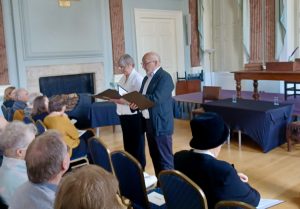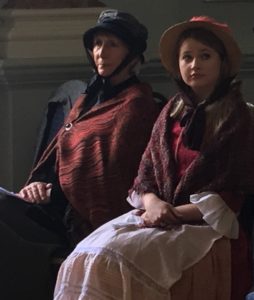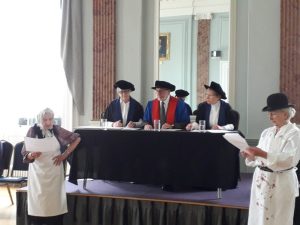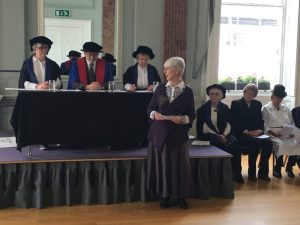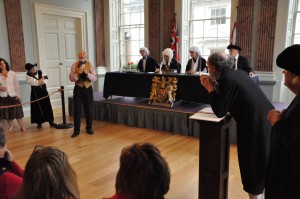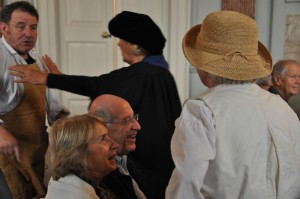Court House Dramas
Unlocking Warwick likes to research and re-enact some of the cases heard in the Court House or in the nearby Warwick Assizes in times past. These cases reveal a great deal about the social history and former living conditions in the town, and the performances bring people into the ballroom, many for the first time.
The Warwick Bank Crash of 1887
When the Warwick Words History Festival resumed in October 2022 after a Covid-19 suspension, Unlocking Warwick presented a dramatic reconstruction of the events following the sudden failure of the Warwick and Warwickshire Bank.
A full-house audience in the Court House Ballroom on the final afternoon of the festival played the role of angry citizens who had lost their savings when the bank closed its doors with massive debts.
According to the Official Receiver, the Greenway brothers who ran the bank, Kelynge and George, a magistrate and the Town Clerk, had traded ‘most recklessly’ investing people’s money in ‘harebrained schemes’. The furious creditors demanded they be put on trial and eventually the Attorney General and Solicitor General agreed to issue warrants for their arrest.
The drama script was based on detailed accounts of the trial which are held in the County Record Office, and it used many of the actual words spoken in court as reported in the newspapers. The players were Unlocking Warwick volunteers, and some guest actors, including a former Mayor and the High Sheriff of Warwickshire who played the judge.
There was enthusiastic praise for the dramatisation from members of the audience. ‘Brilliant’. “We thoroughly enjoyed it!” And warm thanks came from from the Director of Warwick Words, who immediately asked, ‘What are you going to perform next year?”
The Trial of Abraham Thornton for the Murder of Mary Ashford
On the final day of the Warwick Words History Festival in October 2019, a famous murder trial heard in Warwick in 1817 was played-out to a packed audience. The courtroom drama was a collaboration with Warwick School and King’s High School who provided sixth-form students to play the parts of the younger characters, including the accused, Abraham Thornton, a farm worker and bricklayer.
A pretty 20-year-old called Mary Ashford had met Thornton at a late-night Whitsun dance. He walked her home in the early hours and later admitted that he’d been with her at 4 o’clock in the morning and that he’d had intercourse with her. At 6 o’clock, her body was found in a flooded sand pit. She had been brutally assaulted and murdered. The jury in Warwick acquitted Thornton, but the victim’s brother cited an ancient law of England – Dissatisfied Next-of-Kin – and demanded a retrial before the Lord Chief Justice in London. There Thornton responded with another old and disused law that had not been repealed – Trial by Battle!
The audience for the re-enactment in the Court House ballroom joined in enthusiastically with ‘oohs and aahs’ as the evidence unfolded, (word for word from the court records), and some became members of the jury. The reactions afterwards were extremely complimentary. Typical was this, posted on our Instagram site:
“I thought the event was brilliant. I’ve told so many people who might be interested in coming to courtroom re-enactments in the future – if you do them. Well done to everyone involved. It was a thoroughly enjoyable and enlightening evening”.
The 19th Century Warwick Health Board
Guests who came to the social gathering ‘In The Ballroom’ in June 2019 watched a dramatisation of a meeting of the Warwick Board of Public Health in the mid 19th century.
Health Boards had been established in 1849 by Act of Parliament, to oversee the introduction of clean water supplies and proper drainage – to combat the cholera outbreaks that were killing so many people in the towns and cities. Warwick was no exception, with scores of people dying from cholera and smallpox.
The re-enactment was based on authentic accounts of the Health Board meetings found in the County Record Office. These gave a shocking account of drinking water badly polluted by sewage, and cess-pits and open drains making Warwick stink in the summer months!
The dramatisation was performed by the Unlocking Warwick volunteers, and was followed by the usual tea, coffee and cake, and Helen’s picture-quiz which was all about the history of medicine and health care. Here’s a selection of pictures.
The Petty Sessions 1851
In late 2013 the Unlocking Warwick volunteers had begun researching the magistrates’ Petty Sessions that were held at the Court House from when it was built in 1726 until the 1970’s. The main volunteer doing the research, Kate Sargent, chose 1851 as an interesting Victorian year with the Great Exhibition in London celebrating Britains power, innovation and wealth – wealth that had not reached many of the poorer parts of Warwick.
The best source of information about the magistrates’ sessions is the local newspaper, the Warwick Advertiser, where court cases were reported in detail. It was from these cases that volunteer Rick Thompson, with a long career in broadcast journalism, created the first Court House Drama script. The Warwickshire County Record Office in Priory Park has issues of the Warwick Advertiser going back as far as 1806 and continuing into the 1970’s when the paper ceased publication. These newspapers are fully accessible to the public. Leamington’s long standing amateur dramatic group, the ‘Jephson Players’, agreed to enact the Court House Drama along with some of the Unlocking Warwick volunteers.
The play was performed for the first time at the Court House Open Day marking the completion of the refurbishment of the building on May 5th 2014. Since then the dramatic reconstruction has been performed 8 times including once at Warwick University Arts Centre (see Working with Warwick University) and once as part of the Warwick Words literary festival.
As part of the Unlocking Warwick project we asked film-maker Ben Mart to video our first Court House Drama. It can be viewed here.
.
Poverty, Disease and Crime in Victorian Warwick
In 2016 Rick wrote a second dramatic reconstruction based on Kate’s research from 1851. This used an interesting petition from the town’s Inspector of Nuisances, William Thompson, to provide a revealing portrait of the grim conditions in the west and north of Warwick, where thousands of refugees from the Irish famine had crowded into unregistered lodging houses. The sanitation system was overwhelmed and deaths from smallpox and typhus were commonplace. The workhouse was full, and petty crime was rife, often involving heavy drinking and brawling.
In a collaboration with Warwick University this second drama was performed by volunteers and law students to a packed house in the Court House on April 9th 2016, (see pictures below), and again at Warwick University campus during the School of Law Open Day on April 29th 2016.

